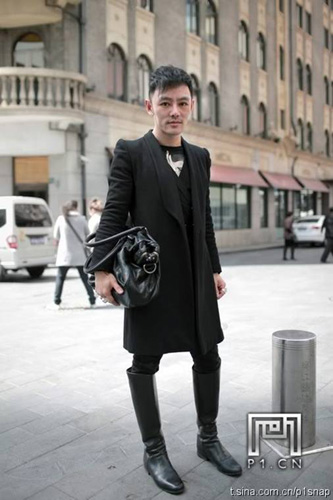The Art of the wardrobe
- By Elsbeth van Paridon
 0 Comment(s)
0 Comment(s) Print
Print E-mail China.org.cn, May 18, 2013
E-mail China.org.cn, May 18, 2013
Sometimes Chinese culture just makes sense. For instance, the popular Weiqi game is often used to teach tactics and strategy, which can be applied to all areas from the boardroom to the battlefield. Speaking of warfare and tactics, Sunzi had a point too. His classic book on military strategy and tactics "The Art of War" features numerous quotes, one of my favorites being: "When you surround an army, leave an outlet free. Do not press a desperate foe too hard." Apply this to fashion and you know it's true: Trying too hard shows. Walking the fine line between looking fashionably fabulous and appearing a fashion failure is indeed a struggle in itself. So how have Chinese men gone about this throughout history?
|
|
|
The modern Chinese guy sacheting down the streets. [Photo: Thebestfashionblog.com] |
China takes great pride in its 5,000-year-long history, just as Carrie did in her Manolos, so this piece is just meant to fill in the biggest gaps. Chinese pre-modern history primarily refers to nine dynasties, starting from the Qin Dynasty in 221 BC until the Last Emperor (Pu Yi, yes, like the movie) of China's last dynasty, the Qing (1644 to 1911/1912, depending on your historical point of view. Over the course of history, rulers of different descents have waived the scepter in China, adding their own personal touch to their subjects' walk-in closets.
|
|
|
The Hanfu has actually gained a new following in recent years -- as proven by the couple in this picture. [Photo: Commons.wikimedia.org] |
Just think of the Mongolian Genghis Khan craze of the Yuan Dynasty (1271 or 1279-1368), with its literally towering headgear, which by the way, was not mandatory attire for all subjects. In stark contrast to Khan's relaxed approach to fashion, the bald Manchu hairdo with a ponytail in the center, which was rocked by the male population during the Qing Dynasty, was obligatory, as was their Changshan style of dress. In fact, many people outside China still consider this style to be China's national costume.








Go to Forum >>0 Comment(s)